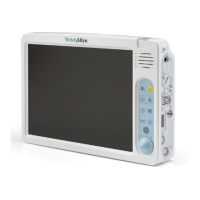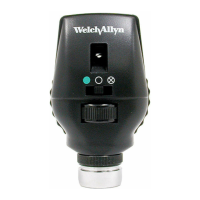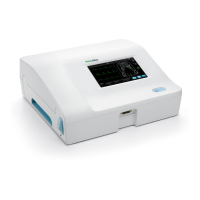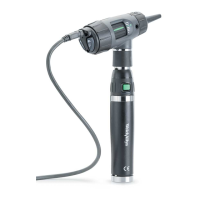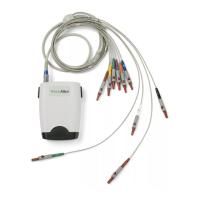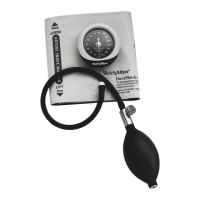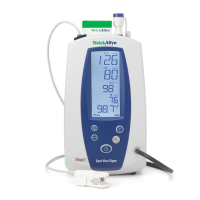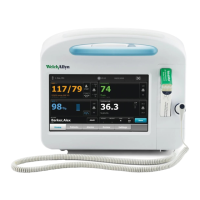
Do you have a question about the Welch Allyn TM 262 and is the answer not in the manual?
| Brand | Welch Allyn |
|---|---|
| Model | TM 262 |
| Category | Medical Equipment |
| Language | English |
Details the warranty terms and conditions for the TM 262 Auto Tymp.
Information on how to obtain service and repair for the instrument.
The TM 262 Auto Tymp is a versatile combination instrument for tympanometry, reflex measurements, and audiometry.
Describes tympanometry as an objective technique for measuring middle-ear mobility and pressure.
Explains acoustic reflex testing, its purpose, and interpretation for screening.
Details manual audiometry for checking auditory pathway integrity and hearing ability.
Provides guidance on proper recycling and disposal of the equipment and its components.
Defines key terms used throughout the manual for better understanding.
Instructions for unpacking the instrument and inspecting it for any signs of damage.
Explains the meaning of different indicator lights (P1, P2, P3) on the probe.
Details the functions of various buttons (F1-F12) and indicators on the front panel.
Describes the instrument's display and printer functions for viewing test results.
Identifies labels and connectors on the rear and bottom panels of the instrument.
Steps for placing the instrument, connecting accessories, and powering it on.
Guidelines for storing thermal printer paper to ensure maximum paper life.
Procedures for performing daily calibration checks using the test cavity.
Instructions for adjusting the instrument for altitude variations to correct ECV measurements.
Procedures related to audiometric testing before performing the main tests.
Explains the importance of noise recovery time before audiometric testing.
Discusses minimizing ambient noise for accurate audiometric test results.
Describes daily checks to ensure the instrument's operating performance.
User-performable maintenance tasks including cleaning the system and eartips.
Instructions for cleaning the exterior of the instrument safely.
Guidance on cleaning and disinfecting eartips for proper use.
Procedures for maintaining the instrument's probe, including cleaning and lubrication.
Detailed steps for removing and cleaning cerumen from the probe nose cone.
Information about the O-Ring on the probe and its lubrication.
Instructions for cleaning the probe wire.
Steps for correctly reassembling the probe after cleaning.
Instructions for cleaning and inspecting earphone cords and cushions.
Recommendations for checking and keeping extra printer paper rolls available.
Guidance and tips for performing tympanometry tests effectively.
Tips for performing tympanometry and acoustic reflex tests effectively on patients.
Guidance on selecting and fitting eartips for a proper seal in the ear canal.
Information and procedures for conducting audiometry tests.
How to explain the audiometry test procedure to patients for clear understanding.
Key steps to ensure a good seal between the earphone cushion and the ear.
Details on using the optional response handswitch for audiometry.
How to enter and configure settings for reflex format, headers, and display options.
Options for displaying and printing reflex test results.
Settings for customizing or disabling the printout header.
Choosing between audiogram or tabular format for printouts.
Enabling or disabling the display of the normal box on tympanograms.
Selecting between normal and narrow frequency ranges for audiometry.
Procedure to exit the program mode and return to the test mode.
Step-by-step procedures for tympanometry and reflex testing.
Detailed steps for performing tympanometry tests without reflex measurements.
Procedure for tympanometry followed by ipsilateral acoustic reflex testing.
How to select and set default frequencies for ipsilateral acoustic reflex tests.
Procedure to exit tympanometry or reflex test modes.
Step-by-step procedures for conducting audiometry tests.
Procedure for conducting screening audiometry tests.
Detailed steps for performing threshold audiometry tests.
Procedure to exit the audiometry mode.
Information on how test results are stored in memory and reviewed.
Procedure for deleting test results from the instrument's memory.
Instructions for printing single tests or all stored test results.
Explains normal and abnormal values for Ear Canal Volume measurements.
Describes normal and abnormal compliance peak values and their implications.
Details normal and abnormal pressure peak values and their relation to middle-ear conditions.
Explains normal and abnormal gradient values and their significance in diagnosing middle-ear issues.
Interprets normal and abnormal acoustic reflex results for screening purposes.
Defines normal and abnormal responses in audiometry testing.
Lists and explains special messages and error codes displayed by the instrument.
Illustrates various test results from sample printouts.
Overview of the RS-232 interface for transferring test results to a computer.
Describes the predefined, fixed-length format for all output data records.
Details the generic structure and fields common to all output records.
Details the data fields and structure for tympanometry and reflex test result records.
Details the data fields and structure for audiometry test result records.
Explains the Auto Repeat Request (ARQ) protocol for reliable data transfer.
How to modify RS-232 interface configuration parameters for data transfer.
Settings required to match the instrument's RS-232 interface to a computer.
Information on connecting the instrument to a computer using RS-232 serial interface.
Explains software XON/XOFF flow control for data transmission.
Technical specifications for tympanometry and reflex testing modes.
Details on frequencies, accuracy, and output levels for acoustic reflex stimuli.
Explanation of indicator lights on the probe and their meanings.
Specifications related to the instrument's pneumatic system, including pressure.
Specifications specific to the audiometry mode of the instrument.
Details on the intensity levels available for audiometry testing.
Electrical power requirements for the instrument.
Operating and storage environmental conditions for the instrument.
Recommended storage conditions for temperature and humidity.
Guidelines for shipping the instrument to maintain its integrity.
Physical dimensions and weight specifications of the instrument.
List of accessories included with the instrument.
List of optional accessories available for purchase.
Product catalog numbers for the instrument and its accessories.

